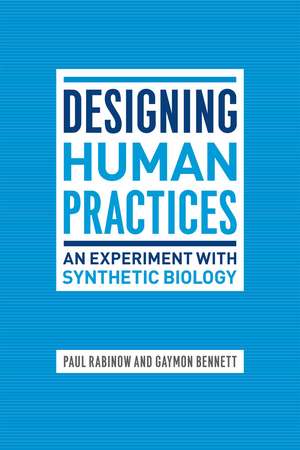Designing Human Practices: An Experiment with Synthetic Biology
Autor Paul Rabinow, Gaymon Bennetten Limba Engleză Paperback – iul 2012
In 2006 anthropologists Paul Rabinow and Gaymon Bennett set out to rethink the role that human sciences play in biological research, creating the Human Practices division of the Synthetic Biology Engineering Research Center—a facility established to create design standards for the engineering of new enzymes, genetic circuits, cells, and other biological entities—to formulate a new approach to the ethical, security, and philosophical considerations of controversial biological work. They sought not simply to act as watchdogs but to integrate the biosciences with their own discipline in a more fundamentally interdependent way, inventing a new, dynamic, and experimental anthropology that they could bring to bear on the center’s biological research.
Designing Human Practices is a detailed account of this anthropological experiment and, ultimately, its rejection. It provides new insights into the possibilities and limitations of collaboration, and diagnoses the micro-politics which effectively constrained the potential for mutual scientific flourishing. Synthesizing multiple disciplines, including biology, genetics, anthropology, and philosophy, alongside a thorough examination of funding entities such as the National Science Foundation, Designing Human Practices pushes the social study of science into new and provocative territory, utilizing a real-world experience as a springboard for timely reflections on how the human and life sciences can and should transform each other.
Designing Human Practices is a detailed account of this anthropological experiment and, ultimately, its rejection. It provides new insights into the possibilities and limitations of collaboration, and diagnoses the micro-politics which effectively constrained the potential for mutual scientific flourishing. Synthesizing multiple disciplines, including biology, genetics, anthropology, and philosophy, alongside a thorough examination of funding entities such as the National Science Foundation, Designing Human Practices pushes the social study of science into new and provocative territory, utilizing a real-world experience as a springboard for timely reflections on how the human and life sciences can and should transform each other.
Preț: 170.42 lei
Preț vechi: 214.03 lei
-20% Nou
Puncte Express: 256
Preț estimativ în valută:
32.61€ • 34.05$ • 26.93£
32.61€ • 34.05$ • 26.93£
Carte indisponibilă temporar
Doresc să fiu notificat când acest titlu va fi disponibil:
Se trimite...
Preluare comenzi: 021 569.72.76
Specificații
ISBN-13: 9780226703145
ISBN-10: 0226703142
Pagini: 200
Ilustrații: 10 tables
Dimensiuni: 152 x 229 x 15 mm
Greutate: 0.29 kg
Editura: University of Chicago Press
Colecția University of Chicago Press
ISBN-10: 0226703142
Pagini: 200
Ilustrații: 10 tables
Dimensiuni: 152 x 229 x 15 mm
Greutate: 0.29 kg
Editura: University of Chicago Press
Colecția University of Chicago Press
Notă biografică
Paul Rabinow is a professor of anthropology at the University of California, Berkeley. He has written numerous books, including Making PCR: A Story of Biotechnology and The Accompaniment: Assembling the Contemporary, both published by the University of Chicago Press. Gaymon Bennett is a senior research fellow at the Center for Biological Futures at the Fred Hutchinson Cancer Research Center. He is coauthor of Sacred Cells? Why Christians Should Support Stem Cell Research.
Cuprins
Acknowledgments
Introduction: A Productive Experiment
PART I. HUMAN PRACTICES: DIAGNOSIS
PART I. HUMAN PRACTICES: DIAGNOSIS
1 The Setting. SynBERC: The Synthetic Biology Engineering Research Center
2 Principles of Design, 2006–2007: From Bioethics to Human Practices
3 Interfacing the Human and Biosciences 2007: Three Modes
4 Synthetic Biology 2008: From Manifestos to Ramifying Research Programs
5 Lessons Learned 2009: From Discordancy to Indeterminacy
2 Principles of Design, 2006–2007: From Bioethics to Human Practices
3 Interfacing the Human and Biosciences 2007: Three Modes
4 Synthetic Biology 2008: From Manifestos to Ramifying Research Programs
5 Lessons Learned 2009: From Discordancy to Indeterminacy
PART II. HUMAN PRACTICES: INQUIRY
6 Recapitulation and Reorientation 2009: The First Wave of Human Practices
7 The Second Wave of Synthetic Biology 2009: From Parts to Ontological Domains
8 A Mode 3 Experiment: Figuring Dual-Use—From Safety to Malice
9 Toward the Second Wave of Human Practices 2010: Figures of Dual-Use, Biopower, and Reconstruction
10 Lessons Learned 2010: From Indeterminacy to Discordancy
Notes Bibliography Index
